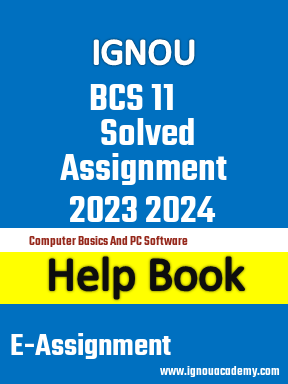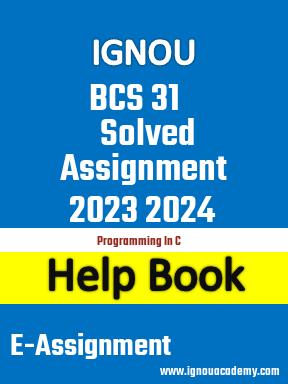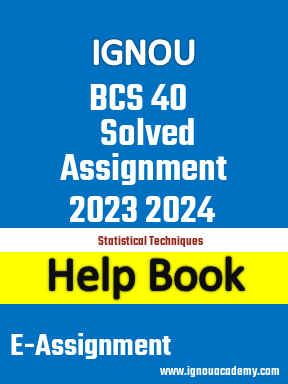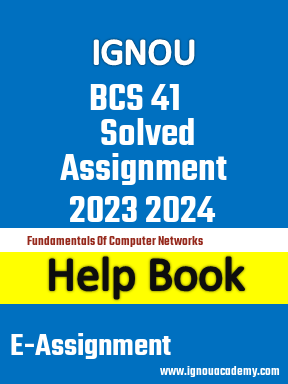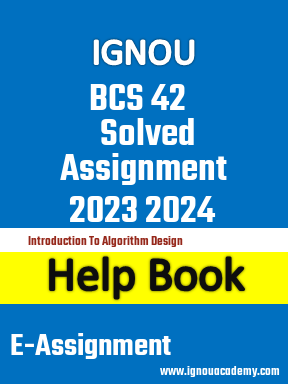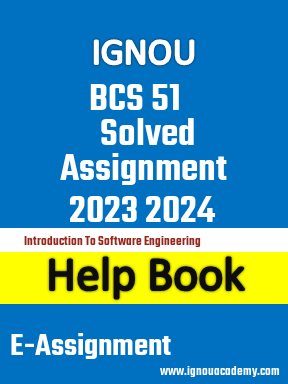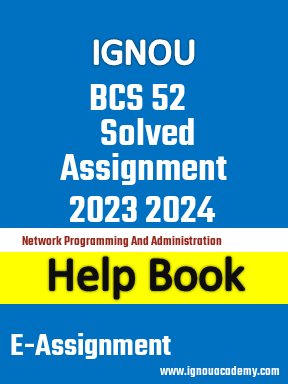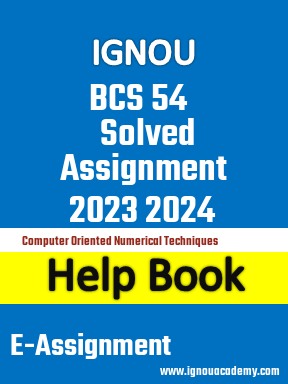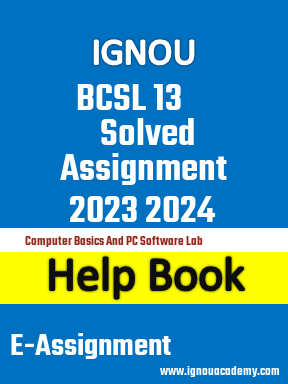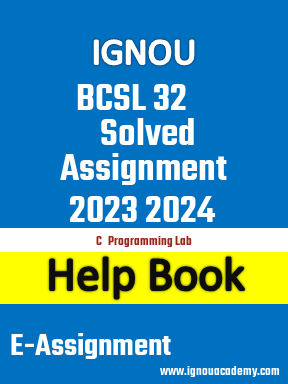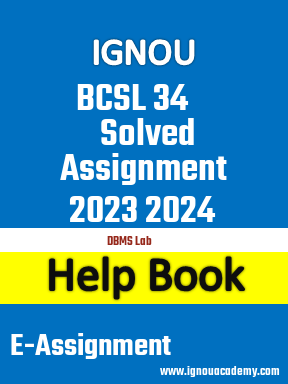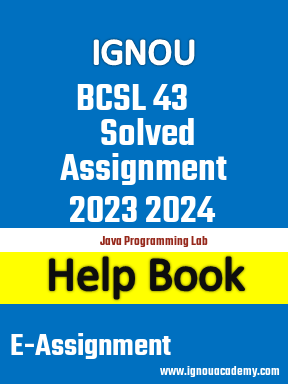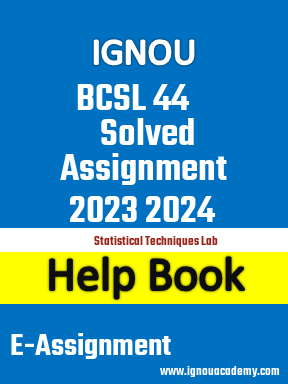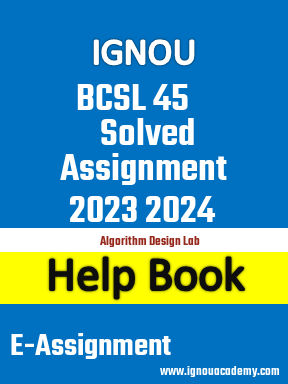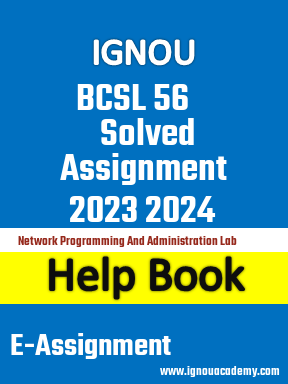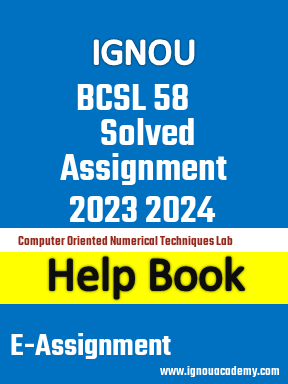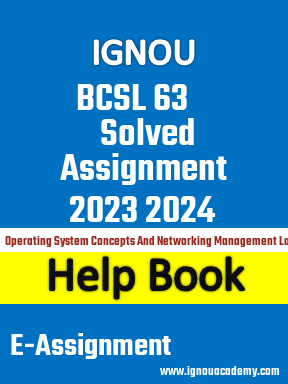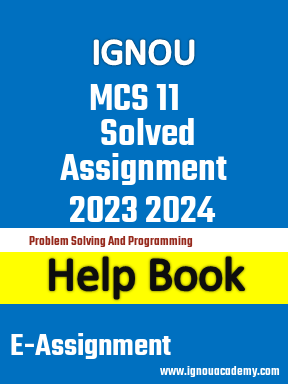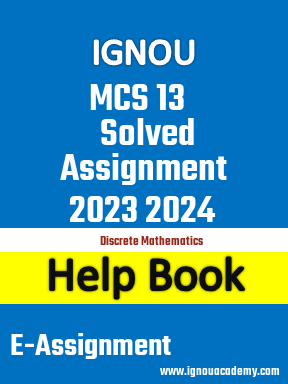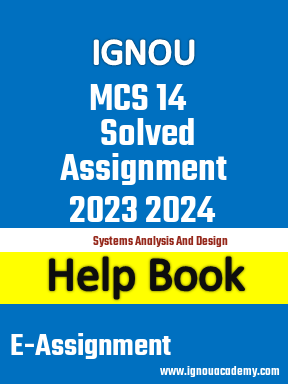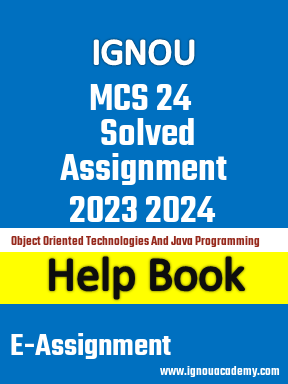My Cart

|
|
IGNOU MCS 12 2023 2024 Solution
IGNOU MCS 12 2023 2024 Solution|
|
| Title Name | ignou MCS 12 solved assignment 2023 2024 |
|---|---|
| Type | Soft Copy (E-Assignment) .pdf |
| University | IGNOU |
| Degree | BACHELOR DEGREE PROGRAMMES |
| Course Code | BCA |
| Course Name | Bachelor of Computer Applications |
| Subject Code | MCS 12 |
| Subject Name | Computer Organization and Assembly Language Programming |
| Year | 2023 2024 |
| Session | - |
| Language | English Medium |
| Assignment Code | MCS-012/Assignmentt-1//2023-24 |
| Product Description | Assignment of BCA (Bachelor of Computer Applications) 2023-24. Latest MCS 012 2023-24 Solved Assignment Solutions |
| Last Date of IGNOU Assignment Submission | Last Date of Submission of IGNOU MCS-012 (BCA) 2023-24 Assignment is for January 2023 Session: 30th September, 2023 (for December 2023 Term End Exam). Semester Wise January 2023 Session: 30th March, 2024 (for June 2024 Term End Exam). July 2023 Session: 30th September, 2023 (for December 2023 Term End Exam). |
| Assignment Code | MCS 12/2023 2024 |
|
|
Questions Included in this Help Book
Ques 1.
Please refer to Figure 4 of Unit 1 of Block 1 on page 11 of the Instruction execution example.
Assuming a similar machine is to be used for the execution of the following three consecutive
instructions:
LODA A ; Load the content of Memory location A into the Accumulator Register.
ADD B ; Add the content of memory location B from Accumulator Register.
STOR C ; Stores the content of Accumulator register to memory location C.
However, this machine is different from the example of Figure 4 in the following ways:
Each memory word of this new machine is of 16 bits in length.
Each instruction is of length 32 bits with 16 bits for operation code (opcode) and 16 bits for
specifying one direct operand.
The Main Memory of the machine would be of size 216 words.
The three consecutive instructions are placed starting from memory location (11FE)h ;
operand A is at location (1FFF)h and contains a value (4321)h, Operand B is at location
(2000)h and contains a value (1FFE)h and operand C is at location (2001)h and contains a
value (0000)h.
The AC, PC, MAR and MBR registers are of size 16 bits, whereas IR register is of size 32
bits. The initial content of the PC register is (11FE)h.
Ques 2.
Initial State of the machine with the addresses and content of memory locations in hexadecimal. Show only those address locations of the memory that store the instruction and data. Also show content of all the stated registers.
Ques 3.
Draw three more diagrams, each showing the state of machine after execution of every instruction viz. LOAD, ADD and STOR. Show the changes in the values of Registers and memory locations, if any, due to execution of instruction. Show all the addresses and values in hexadecimal notations.
Ques 4.
Perform the following conversion of numbers:
i) Decimal (345654398)10 to binary and hexadecimal
ii) Hexadecimal (FFEEDDCBA)h into Octal.
iii) String “Computer Organisation” into UTF 8
iv) Octal (6754632)O into Decimal
Ques 5.
Simplify the following function using K-map: F(A, B, C, D) = Σ (1, 3, 4, 7, 11, 13) Draw the circuit for the resultant function using NAND gates.
Ques 6.
Consider the Adder-Subtractor circuit as shown in Figure 3.15 page 76 of Block 1. Explain how this circuit will perform subtraction (A-B), if the value of A is 1011 and B is 0011. You must list all the bit values including Cin and Cout and overflow, if any
Ques 7.
Explain the functioning of a 3 × 8 decoder with the help of logic diagram and example input
Ques 8.
Assume that a source data value 1011 was received at a destination as 1010. Show how Hamming's Error-Correcting code bits will be appended to source data to identified and correct the error of one bit at the destination. You may assume that transmission error occurs only in the source data and not the source parity bits
Ques 9.
Explain the functioning of the D flip-flop and the T flip-flop with the help of a logic diagram and characteristic table. Also, explain the excitation table of this flip-flop
Ques 10.
Explain the functioning of the edge-triggered flip-flop with the help of a diagram.
Ques 11.
Represent (-121.25)10 and (0.0625)10 in IEEE 754 single precision and double precision formats
Ques 12.
Refer to the Figure 2(b) on page 8 in Unit 1 of Block 2. Draw the Internal organisation of an 8×8 RAM. Explain all the Input and Output of this organisation. Also answer the following:
Ques 13.
How many data input and data output lines does this RAM needs? Explain your answer
Ques 14.
How many address lines are needed for this RAM? Give reason in support of your answer.
Ques 15.
A computer has 64 K Word RAM with each memory word of 16 bits. It has cache memory
having 32 blocks having a size of 32 bits (2 memory words). Show how the main memory
address (1AFC)h will be mapped to the cache address, if
(i) Direct cache mapping is used
(ii) Associative cache mapping is used
(iii)Two way set associative cache mapping is used.
You should show the size of tag, index, main memory block address and offset in your answer.
Ques 16.
What is an Interrupt? Why are interrupts used in a computer? Explain different kinds of interrupts. Also, explain the process of interrupt processing.
Ques 17.
What is an I/O processor? Explain the selector channel structure in the context of the I/O processor. How is an I/O processor different from DMA?
Ques 18.
Assume that a disk has 32 tracks, with each track having 16 sectors and each sector is of size 512 Kilobytes. The cluster size in this system can be assumed to be as 2 sectors. A file having the name mcs012.txt is of size 16 MB. Assume that it is a new disk, and the first 8 clusters are occupied by the Operating System. Rest all the clusters are free. How can this file be allotted space on this disk? Also, show the content of FAT after the space allocation to this file. You may make suitable assumptions
Ques 19.
Rotational Latency in disks
Ques 20.
Programmed I/O
Ques 21.
Resolution of Display and Printer
Ques 22.
Zip Drive
Ques 23.
Power Supply
Ques 24.
Keyboard and Mouse
Ques 25.
A single-core uniprocessor system has 8 General purpose registers. The machine has RAM of size 64K memory words. The size of every general-purpose register and memory word is 16 bits. The computer uses fixed-length instructions of size 32 bits each. An instruction of the machine can have two operands. One of these operands is a direct memory operand and the other is a register operand. An instruction of a machine consists of bits for operation code, bits for memory operand and bits of register operand. The machine has about 128 different operation codes. The special purpose registers, which are other than general purpose registers, are - Program Counter (PC), Memory Address Register (MAR), Data Register (DR) and Flag registers (FR). The first register among the general-purpose registers can be used as Accumulator Register. The size of Integer operands on the machine may be assumed to be equal to the size of the accumulator register. To execute instructions, the machine has another special register called Instruction Register (IR) of size 32 bits, as each instruction is of this size. Perform the following tasks for the machine. (Make and state suitable assumptions, if any.)
Ques 26.
Design suitable instruction formats for the machine. Specify the size of different fields that are needed in the instruction format. Also, indicate how many bits of the instructions are unused for this machine. Explain your design of the instruction format. Also, indicate the size of each register.
Ques 27.
Demonstrate two valid instructions of the machine; put some valid data values in registers and memory locations and show these two instructions.
Ques 28.
Assuming that the instructions are first fetched to the Instruction Register (IR), the memory operand is brought to the DR register and the result of an operation is stored in the Accumulator register; write and explain the sequence of micro-operations that are required to fetch and execute an addition instruction that adds the contents of the memory and register operands of the instruction. The result is stored in the accumulator register. Make and state suitable assumptions, if any.
Ques 29.
Assume that you have a machine, as shown in section 3.2.2 of Block 3 having the microoperations given in Figure 10 on page 62 of Block 3. Consider that R1 and R2 both are 8-bit
registers and contain 11100111 and 00111100 respectively. What will be the values of select
inputs, carry-in input, and the result of the operation (including carry-out bit) if the following
micro-operations are performed? (For each micro-operation you may assume the initial value
of R1 and R2 as given above)
(i) Decrement R1
(ii) Add R1 and R2 with Carry
(iii) Exclusive OR of the registers R1 and R2
(iv) Shift right R1
Ques 30.
Consider that an instruction pipeline has three stages namely instruction fetch and decode (FD), Operand Fetch (OF) and Instruction Execute and store results (ES). Draw an instruction pipeline diagram showing the execution of five sequential instructions using this pipeline. What are the problems with this instruction pipelining?
Ques 31.
Explain the functioning of the Wilkes Control Unit. Also, explain the format of the control memory with the help of a diagram.
Ques 32.
Explain the characteristics of RISC? Also, explain the RISC pipelining
Ques 33.
Write a program using 8086 assembly Language (with proper comments) that accepts three different digits as input from the keyboard. Each digit is first converted to a binary equivalent. The binary values of these three digits are compared and the middle value is put in the AL register. This AL register is multiplied with each value of a byte array of size 6, which is stored in the memory. The result of the multiplication is stored in the same memory location. You may assume the byte array has the values 02h, 06h, 08h, 03h, 01h, 05h. Make suitable assumptions, if any.
Ques 34.
Write a NEAR subroutine using 8086 assembly Language (with proper comments) that returns the average value of the values stored in a byte array of length 3. All three values of the byte array are passed to the subroutine in the stack. You should write both the calling program and subroutine.
Ques 35.
Explain the following in the context of 8086 Microprocessor with the help of an example or a
diagram:
(i) Use of code segment and stack segment registers for computing the respective 20-bit
addresses.
(ii) Any 4 flags of the flag register of 8086 micro-processor
(iii) Any four shift instructions of 8086 micro-processor
|
|
Related Assignments
IGNOU Doubts & Queries
Click to Contact Us
Call - 9199852182 Call - 9852900088 myabhasolutions@gmail.com WhatsApp - 9852900088